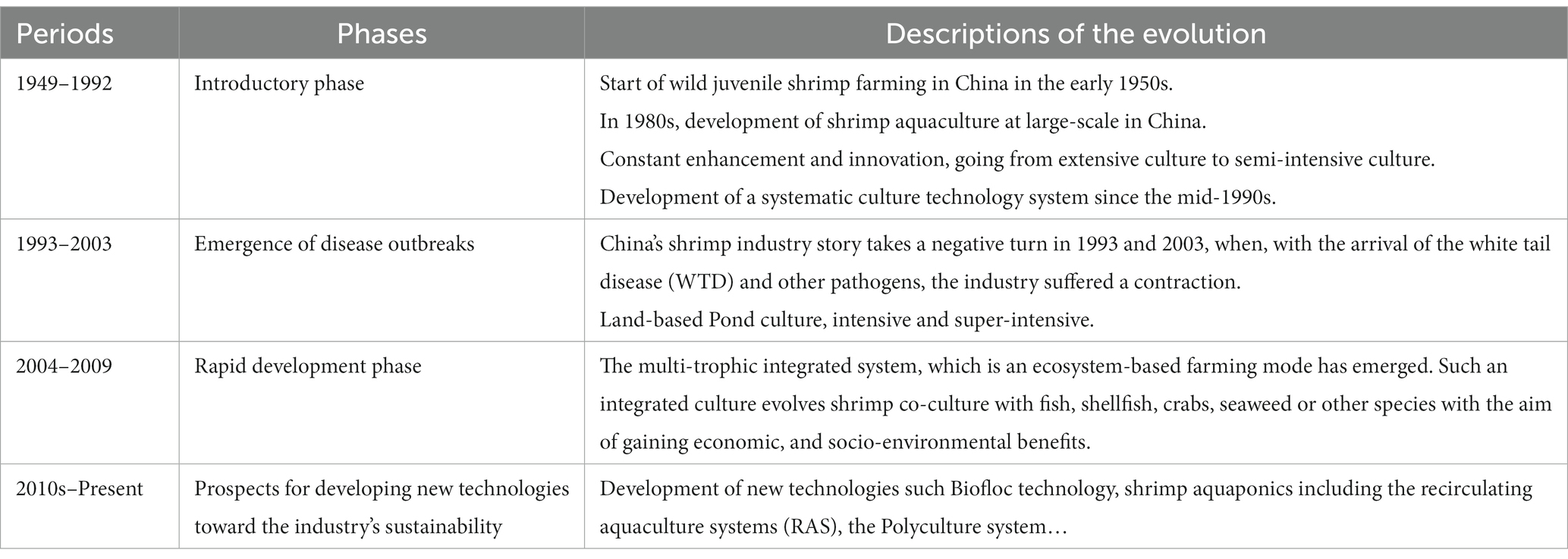- 1College of Economics and Management, Shanghai Ocean University, Shanghai, China
- 2Faculté des Sciences Economiques et de Gestion (FaSEG), Université de Lomé, Lomé, Togo
China’s shrimp farming industry has experienced significant growth in recent years. With such a development, some major constraints linked to the industry’s sustainable development have emerged. This paper aims to present an overview of China’s shrimp industry over the last two decades, with special attention to farm-raised shrimp both in marine and inland waters. Documentary research on its recent evolution was carried out based on data collected from China Fishery Statistics Yearbooks 2003 to 2022 coupled with data from FAO. Findings indicated that there has been an upward trend in China’s total shrimp production over the last 20 years, with a growth rate of 120%, representing an average annual growth rate of 4.3%. The observed higher shrimp production was driven by expanded shrimp aquaculture production, with major species dominated by the Pacific whiteleg shrimp (litopenaeus vannamei), the black tiger shrimp (Penaeus monodon), the Chinese shrimp (Penaeus chinensis), and the Japanese prawn (Penaeus japonicus). Challenges associated with the intensification of the production and the driven environmental deterioration need to be properly addressed. First, the shrimp farming industry should be practiced while considering both environment and ecosystem protection. Applying such an organic farming principle presupposes some practices for addressing the existing issues threatening the sustainable growth of the industry. To that end, there is a need for innovative techniques that should be strengthened. Second, possible solutions to shrimp disease problems, namely prevention, early diagnosis, and various control techniques, should also be developed and improved, with an emphasis on the former. In addition, encouraging the use of good-quality feed in appropriate quantity and form is also of paramount importance. It is thus worth noting that further policies need to focus on promoting a large range of ecological shrimp aquaculture technologies that should be encouraged among farmers.
1 Introduction
Aquaculture has become a flourishing industry by undergoing a particular intensification process in recent years (Dong and Raghavan, 2022). Shrimp aquaculture industry has enjoyed phenomenal growth during the 1980s and has become the leading contributor to the world’s fishery production in recent years (FAO, 2021; Yu et al., 2023). The latter was reported to be the second largest seafood traded worldwide after salmon fisheries (FAO, 2019). In today’s world, there is a high demand for seafood products, but the supply from wild-stock fisheries is not enough to meet this demand. As such, the aquaculture industry as a whole and shrimp aquaculture in particular can be an alternative food source to compensate for the shortages. This can help address the increasing food scarcity and reduce the pressure on wild fisheries (Mansour et al., 2022).
Asian countries led by China, were the main fisheries and aquaculture producing countries, representing 70% of the global production in 2020 (FAO, 2022). Since 1991, China has remained the top producer of farmed aquatic animals and algae in the world, with its shares being 56.7% and 59.5%, respectively, in 2020. Indeed, aquaculture industry exists in almost every province in China, with its major areas located in the southeast coastal watershed and the middle and lower reaches along the Yangtze River (Chao et al., 2017). Precisely, pond and freshwater aquaculture production in China are mainly concentrated in Guangdong, Hunan, Hubei, Jiangxi, Anhui, Jiangsu, Shandong, and Sichuan (Hu et al., 2021).
The People’s Republic of China has been one of the world’s leading shrimp producing countries since the late 1980s (Biao and Kaijin, 2007). China’s shrimp industry faces potential long-term challenges despite short-term yield success (Dong and Raghavan, 2022). Although the shrimp industry is widely researched, with many studies reporting on breeding, growth performance, genetics or genomic aspects and experimental conditions and/or observations (e.g., Li et al., 2021; Abdel-Latif et al., 2022; Liu et al., 2023; Huang et al., 2024), little is known on the current status, evolution and prospective of China’s shrimp industry. Regarding both its marine and freshwater shrimp aquaculture, no abundant information was found that reviewed the trends in shrimp production over the last two decades. As such, there is insufficient scientific information available on these particular aspects. The available recent studies on similar matter were found performed on the tendencies and dynamics of aquaculture ponds at provincial levels (e.g., Duan et al., 2021; Fu et al., 2021). However, given the importance of shrimp as one of the major aquatic products in China, presenting an overview of key features of the industry is crucial for understanding the drivers of its aquaculture development and dynamics. This could also help overcome issues that challenge the industry and thus plan consistently what should be the way ahead. To that end, there is a need to review the trends in its shrimp aquaculture production, imports into China and exports from China in recent years and thereafter make policy recommendations, whose implementation could help the country maintain its leading position in the global shrimp industry.
Therefore, this paper presents an overview of the current state of the Chinese shrimp industry. This review helps understand the trends in China’s shrimp production, imports and exports during the last two decades, and challenges that have emerged.
The remainder of the paper is organized as follows: Section 2 describes the methodological approach and the data sources. Section 3 presents the results of the overview of the current state of the Chinese shrimp industry, by considering both wild-caught and aquaculture species, both freshwater and marine shrimp species. Then, the discussions are presented in Section 4, in particular by focusing on the progress in shrimp aquaculture modes and technologies in China. Besides, the needs to keep on improving the quality of the fries, combating water pollution and thus developing ecological and healthier shrimp aquaculture are also discussed. Finally, the paper concludes with Section 5, which includes remarks, implications and outlook.
2 Methodological approach
This study was mainly conducted through desk research from April 16, 2023, to August 30, 2023. As a first step, we carried out a systematic review to map relevant literature. This consisted of (1) identifying relevant studies, (2) screening and selecting relevant publications, (3) charting the data and information, and then (4) summarizing the results (see Figure 1). To this end, we used a group or set of keywords (related to China’s shrimp industry, ecological shrimp aquaculture, trends in China’s shrimp imports and exports, challenges, and outlook) to search in two scientific databases. The first was Scopus, and the second one was Clarivate Analytics Web of Science (WoS), which were both used as research tools to obtain reliable and relevant results. We particularly opted for the WoS given it is a widely accepted and comprehensive bibliometric database (Zhu and Liu, 2020). For this present review, a checklist of criteria was used to determine which publications to include. Particularly, the selected publications were required to meet the following criteria: (i) They should be focused on shrimp aquaculture or capture and be topically relevant, (ii) They should meet academic quality standards, which means only scientific, technical, and academic documents will be considered, (iii) They should have been published in the last 15 years (between 2008 and 2023), (iv) They should be written in English, and (v) They should focus on the geographic location of China. As such, relevant terms were combined with shrimp industry and/or china and other concepts. The syntax were, among other, “Shrimp industry” AND “China” AND “last two decades,” “Shrimp aquaculture” AND “China” AND “last two decades,” “Shrimp production*” AND “exports OR imports “AND “China” AND “last two decades,” “Shrimp industry*” AND “marine AND freshwater” AND “exports OR imports “AND “China*” AND “last two decades,” “Shrimp industry*” AND “wild caught AND aquaculture” AND “marine AND freshwater” AND “exports OR imports “AND “China*” AND “last two decades,” etc. This helped us locate various types of published materials such as research articles, review papers, books, and technical reports.
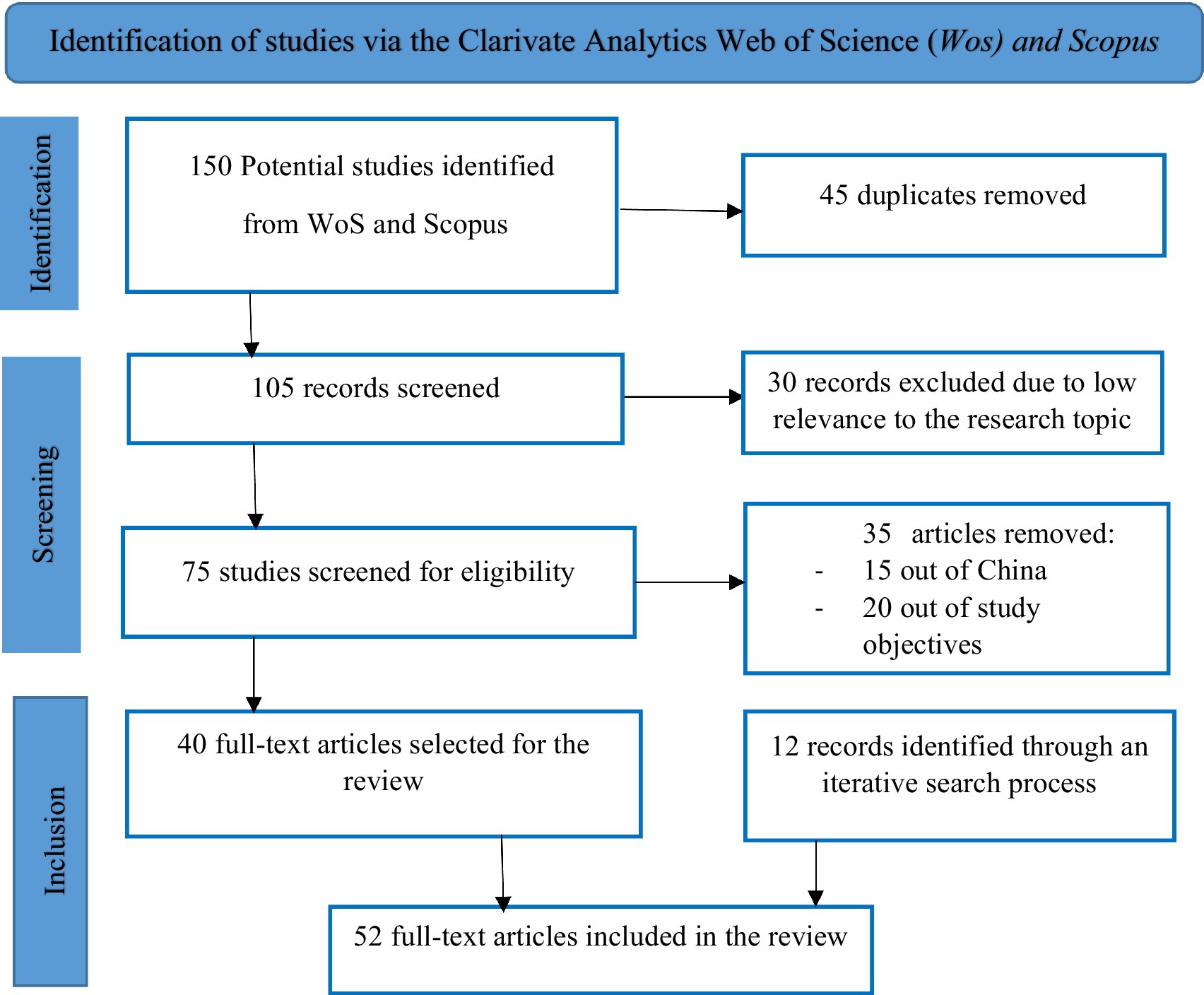
Figure 1. Flow chart of the selection process of studies examining shrimp industry in China and trends in production, imports and exports over the last two decades.
In other words, the review of possible available information regarding China’s shrimp aquaculture industry has been conducted using key published reports and official databases. Overall, the search approach yielded 150 publications. Thereafter, we eliminated duplicates and 105 publications remained. After screening the articles ‘titles and abstracts, 75 potentially relevant publications were considered. After evaluating and reading the full-text articles, 40 papers were found to meet the inclusion criteria for this review. In addition, this review contained twelve (12) records that were identified through a two-step iterative search process. This process consisted of reviewing available literature, choosing pertinent papers for inclusion, checking the presented information, and evaluating whether it fitted properly the objectives of this study.
We then addressed the objectives of our study, which, were to: (1) present an overview of and develop a better understanding of the industry, and (2) identify challenges and/or issues currently faced by the shrimp industry in China by collecting secondary data from China Fishery Statistical Yearbooks, spanning from 2003 to 2022. In addition, data on trends in shrimp production for the world’s top ten shrimp producers (2002–2021), imports and exports (2018–2022) were provided by FAO.
3 Results
3.1 Development history of shrimp aquaculture in China
Fish farming in ponds is a long-standing practice. Early farmers probably developed it as one of their initial farming systems for household food security and income generation. The earliest recorded instances of fish farming in ponds were found in China, about 4,000 years ago, and in Mesopotamia, around 3,500 years ago (FAO, 2000). The historical evolution of China ‘shrimp industry can be categorized into three development phases, namely the start-up phase, new phase, and the rapid development phase (Table 1).
3.1.1 The start-up: 1949–1992
Shrimp farming in China started in 1950s but its extensive farming inception began in the late 1970s, along the eastern coast (Wang et al., 2022). In the introductory phase of shrimp farming, the yield was low; the shrimps were primarily farmed for family consumption and gradually sold in the local market. In 1978, a panel of scientists was established by the government to develop technologies for the country’s shrimp farming intensification. This involved high density shrimp farming with hatchery-bred shrimp, processed feed, regular water exchange, and mechanization using many techniques and tools. Indeed, China implemented reform and open-up policies in 1978 (Zhang, 2007), which, among others, helped bolster a rapid expansion of its fisheries in order to meet the increasing demand for fish and fishery products by its growing population (Li et al., 2011). A general plan, which was drawn up for fisheries and aquaculture development in China, contained the following goals:
• To promote the transformation of the fishery economic system, including its expansion, based mainly on the socialist market economy principles;
• To promote fisheries and aquaculture through education, science and technology, and new strategies implementation;
• To achieve optimal fisheries production, the industrialization of production system, farming of high-value species, pond-culture operations, etc., should be intensified;
• To prioritize seed production as the foundation and emphasize sustainable fisheries, and quality of aquatic products, and;
• To industrialize fisheries and aquaculture in a coordinated way, which will help improve agriculture, rural economy, and rural population livelihoods.
Thus, considerable efforts in terms of on-farm technical supports and extension services were undertaken by fishery research institutes and technology promotion departments at different levels towards the farmers. At the same time, the government invested considerable funds in the country’s aquaculture development. Such projects were funded through loans from the World Bank, local government investments, and labor contributions. Besides, to ensure the successful execution of the fisheries promotion through science and technology, the central and local governments have invested significant funds in establishing a national aquaculture technical training and extension networks. They were set at different administrative levels in the country and the stations included at provincial, prefecture, county, and village levels, were 37, 206, 116 and 1,155, respectively. Every station was furnished with suitable equipment and training facilities. Furthermore, a system that comprised fishery administration, 25 specialized farms, and environmental protection, etc., has been established to promote high-value species (Wang, 2001).
Between 1980 and 1988, shrimp production grew by an average of 75% annually. Indeed, by 1980, shrimp farms in China spanned across 9,342 hectares and produced around 2,549 metric tons. However, in 1988, the farms expanded to cover 162,960 hectares and yielded roughly 200,000 metric tons of shrimp (Wang, 2001). Such expansion led China to become the largest shrimp producer worldwide. The country’s shrimp production was mainly dominated by Penaeus orientalis (ADB/NACA, 1996).
3.1.2 Emergence and spread of diseases: 1993–2003
Like Taiwan province, whose shrimp industry collapsed in 1987, shrimp aquaculture industry in mainland China was exposed to some diseases in 1990 and 1993 (Wang et al., 2022). China’s farm-raised shrimp production increased to 200,000 metric tons per year from 1988 to 1992. However, the country faced new challenges starting from 1993. Between 1993 and 1994, its shrimp production crashed to about 50,000 metric tons. The first disease occurrence in the shrimp industry was due to factors including the misuse of antibiotics, overstocking, inappropriately processed food, and over-exploitation of groundwater (Kautsky et al., 2000). Again, a virus, which appeared coupled with industrial and domestic pollution around the Gulf of Bohai Sea, hit the industry. In addition, China’s fish (shrimp) ponds are basically located in low-lying areas. This makes it difficult to clean up bottoms in terms of pond management between harvests. But very quickly, China’s brackish water shrimp breading demonstrated evidence of recovery between 1994 and 2000. In addition, given the ever-increasing demand for shrimp on the international market, the potential and real profit as well as the improvement in technologies used have led to the growth trends of the industry. As such, shrimp output increased on average by 23% per year from a low of 64,000 metric tons in 1994 to reach 218,000 in the early 2000s.
3.1.3 Rapid development phase: 2004–2009/2010
Shrimp farming in China had another period of rapid development from 2004 to 2010. The production of cultured freshwater prawns increased rapidly with the implementation of more intensive farming and improved culture techniques. The production area increased quickly during this period before a serious disease outbreak of acute hepatopancreatic necrosis disease (AHPND) also known as early mortality syndrome (EMS) of shrimp in China in 2009 (Thitamadee et al., 2016), which caused high shrimp mortalities of L. vannamei and P. monodon in southern China (Thitamadee et al., 2016) and spread sequentially to Vietnam (2010), Malaysia (2011), Thailand (2012) (Joshi et al., 2014). The AHPND caused significant economic losses among shrimp producers in China, estimated to USD 11.0 billion from 2009 to 2016 (Shinn et al., 2018; Estrada-Perez et al., 2020). The spectacular new recovery of the country’s shrimp production resulted from increases in the production area and stocking density and technological improvements.
In terms of cultured species, the farming of pioneer shrimp species in China, started in the 1950s. Some years later, the Institute of Oceanology of the Chinese Academy of Sciences introduced Litopenaeus Vannamei, the Pacific white shrimp, to China in 1988. Since 1992, the nursery barrier has been broken and the Vannamei farming has developed throughout China. Meanwhile, Chinese shrimp (Penaeus chinensis) remained the major farmed shrimp species in China until 1995, and its farming was primarily concentrated in the provinces along the coast of the Yellow Sea (Meng et al., 2015). At present, Guangdong, Guangxi, Fujian, Hainan, Zhejiang, Shandong and Hebei have gradually promoted their farming along with that of many other species.
3.2 Overview of the current status of shrimp industry in China (2010–present)
China is the main producer of aquatic food in East Asia, which contributed 77% to global aquaculture production in 2017 (MacLeod et al., 2020). Shrimps have become of increasing economic importance in China. The past two decades have witnessed a significant increase in China’s total shrimp production (both wild-caught and aquaculture) by around 120%, from 3.2 million MT in 2003 to 7.07 million MT in 2022 (Figure 2). This represents an average annual growth rate of 4.3%. With such an upward trend and rapid growth, China overtook the leading suppliers and became the world’s top shrimp producer. Meanwhile, there was a slight decrease in China’s shrimp output in 2008 and 2016 as compared to their previous year, of 1 and 1.8%, respectively.
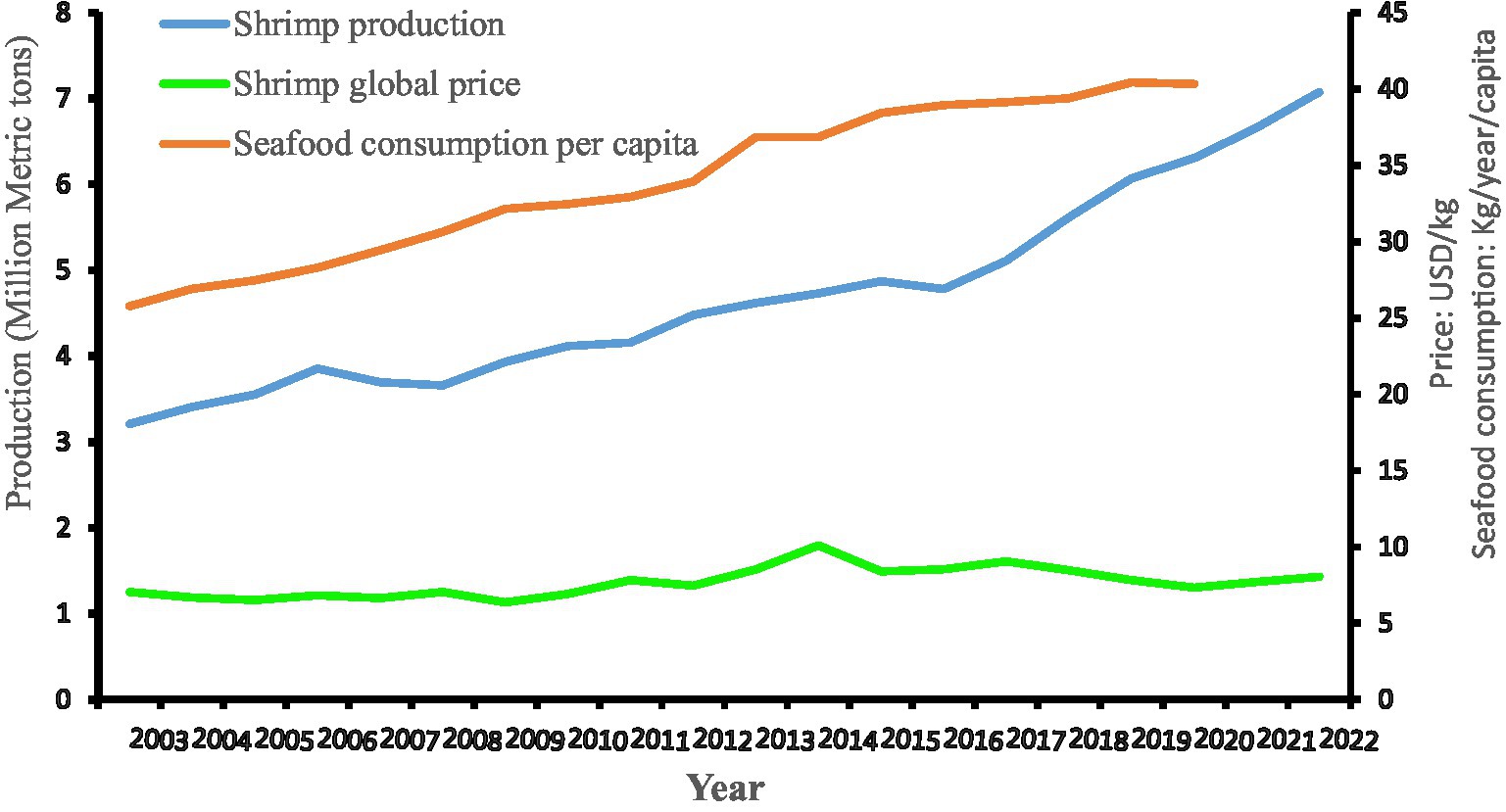
Figure 2. China’s total shrimp production over the last two decades, 2003–2022. Source: Authors, based on data from China Fishery Statistical Yearbooks, 2003–2022, FAOSTAT (2023) and IMF (2023).
During the study period, seafood products consumption per capita in China and the global price of shrimp also exhibit upward trends. With Chinese consumers increasing their spending on high quality, value-added fish and seafood products (Wang et al., 2021), per capita consumption of fish and seafood in China jumped more than one-half from 25.77 kg/capita in 2003 to 40.33 kg/capita in 2020 (FAOSTAT, 2023). In recent years, the volume of seafood, including shrimp consumed by person in the country had increased slightly. At the same time, the global price of shrimp also had been fluctuating, wherein values varied from 7.05 USD/kg in 2003 to 8.04 USD/kg in 2022, and had reached the highest of 10.1 USD/kg in 2014 (IMF, 2023), as observed in Figure 2.
In a comparative view, it can be seen in Figure 3 that China’s aquaculture shrimp was particularly higher and had outweighed that of other shrimp producing countries over the last two decades (Fu-Chi, 2023). Indeed, aquaculture shrimp in China has increased by around 194% from 1.11 million MT to 3.27million MT, from 2003 to 2022 (e.g., Wang et al., 2022). In contrast, aquaculture shrimp has decreased by 6% in the United States over the same period. Similarly to China, aquaculture shrimp has almost tripled in India (Kumar, 2022). Again, farmed shrimp has also almost tripled in Indonesia while it has quadrupled in Viet Nam (3.14%) and Argentina (3.33%) in the recent two decades. Ecuador is the country that witnessed the fastest growth rate (12.69%) for farmed shrimp over the same period (Van der Pijl, 2023), which is evident from the perspective of many policies and interventions toward fisheries development, with particular emphasis on shrimp aquaculture (Boyd and McNevin, 2018). The development of local technicians’ capabilities enabled by improved environmental stewardship also contributed to this. It is worth noting that within the first half of the period under investigation, Thailand shrimp production had slightly increased and thereafter, there was a considerable decrease in the country’s shrimp production between 2012 and 2014. The years after, although an observable steady increase, the volume of its shrimp production was remained smaller than that of the 2000s. Overall, as, it can be seen in Figure 3, there was an upward trend in China’s aquaculture shrimp production over time.
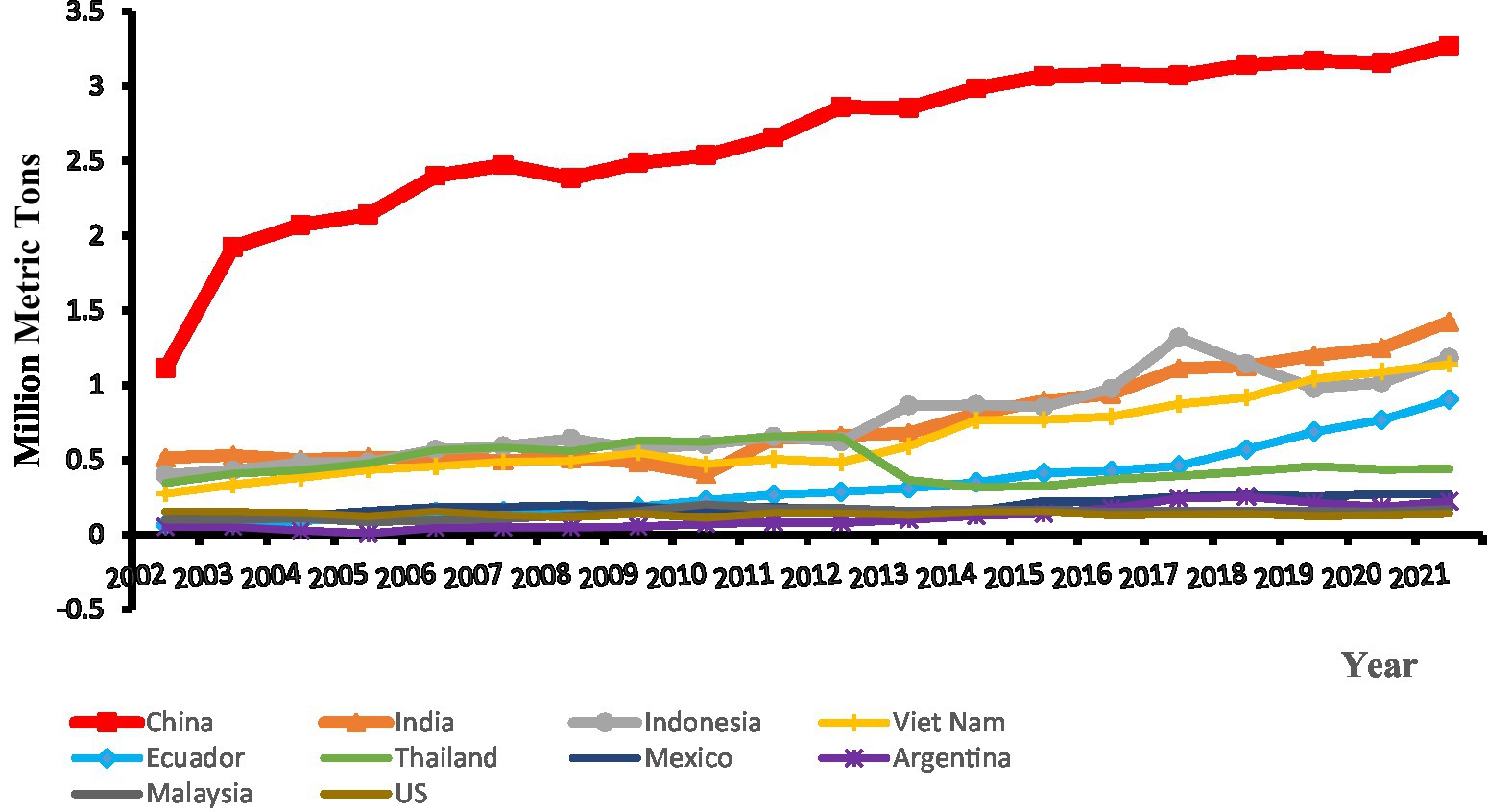
Figure 3. Trends in shrimp production for the world top ten shrimp producers, 2002–2021. Source: Authors, based on data from FAO database 2023.
3.3 Shrimp species farmed and caught in China
The diversity of the shrimp species is such that it is not possible to discuss them all in detail in this report. If we arbitrarily consider species to whose annual volume production represents individually more than 5% of national shrimp production, five species stand out. First, white-leg shrimp, litopenaeus vannamei. Second, the giant freshwater prawn Macrobrchium_Rosenbergii. To this group should be added the giant tiger shrimp, Penaeus monodon and a key species of freshwater shrimp in China, the so-called, Macrobrachium nipponensis, the Chinese white shrimp, Penaeus chinensis. Likewise, globally, L. vannamei is the most important species in China, with the main proportion of its production coming from aquaculture.
3.3.1 Marine shrimp aquaculture
Marine shrimp aquaculture has been one of the most important industries in the field of marine economy development in China. The main species cultured are Chinese shrimp (Penaeus chinensis); Pacific white shrimp (litopenaeus vannamei); black tiger shrimp (Penaeus monodon); and Kuruma shrimp (Marsupenaeus japonicus). P. chinensis, whose farming in China, started in the 1950s was the major farmed shrimp species in China until 1995, particularly in the provinces comprising its natural distribution along the coast of the Yellow Sea (Meng et al., 2015; Deng et al., 2023). However, since 1995 and over the last two decades, shrimp output increases in China, have mostly come from L. vannamei (Figure 4). For example, in 2022, China harvested more than 1.5 million metric tons of shrimp from marine aquaculture, with L. vannamei accounting for 1,340 280 tons, or more than 80% of the total. The production of P. chinensis (30,929 tons), Spot shrimp (114,360 tons) and M. japonicus (46,199 tons) also contributed relatively small shares.
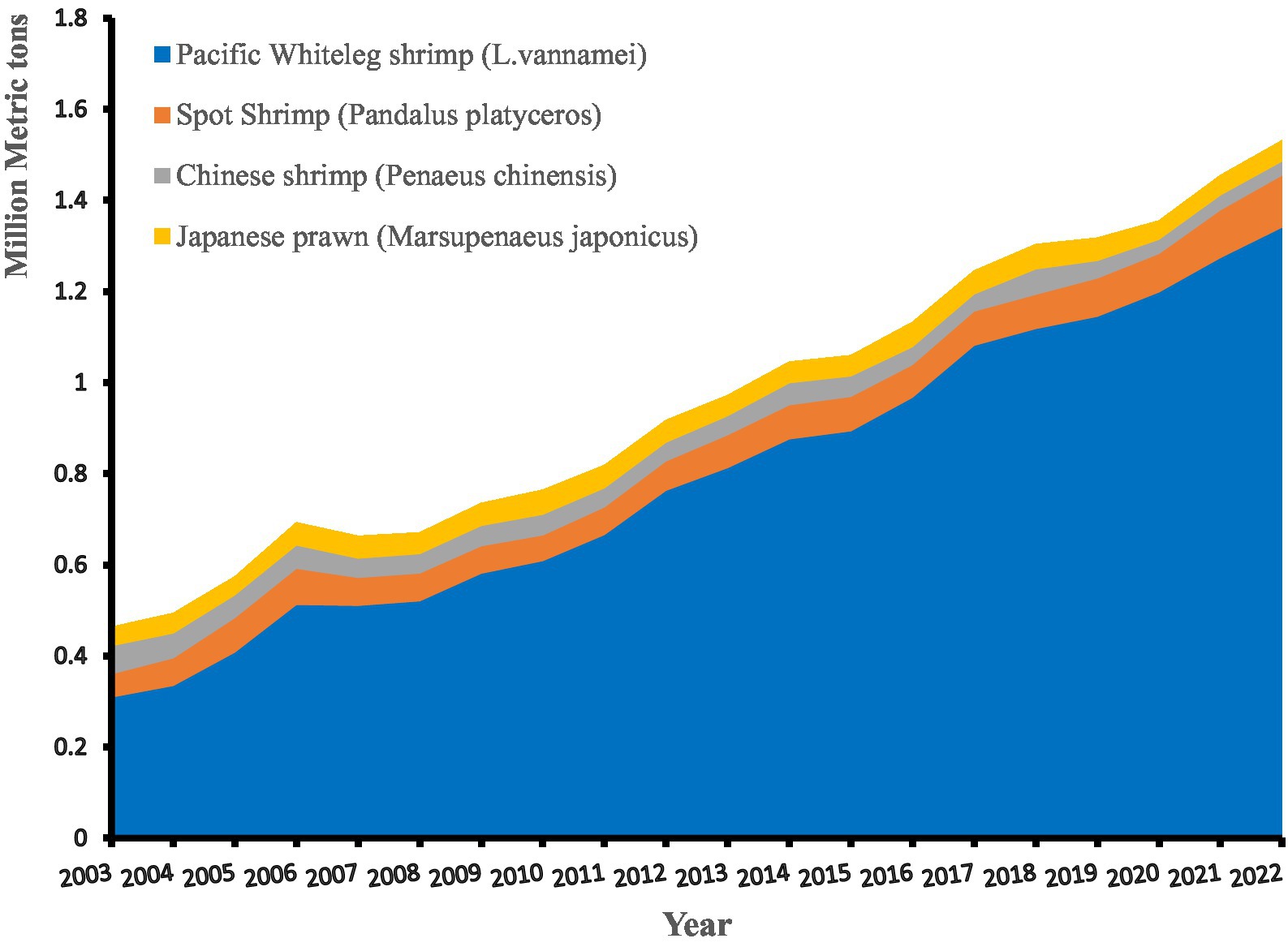
Figure 4. Trends in China’s shrimp marine aquaculture by major species. Source: Authors, based on data from China Fishery Statistical Yearbooks, 2003–2022.
3.3.2 Major shrimp aquaculture species in Chinese inland waters
The development of aquaculture production in China has enabled the country to reduce its dependence on food fish supplies from a hunted to a farmed origin. Inland aquaculture has been fundamental to aquaculture growth in China, with particular attention given to some traditional species (Newton et al., 2021). In the shrimp industry, the available data show that freshwater culture was dominated by the western some imported species until recent years (e.g., Han et al., 2021). From 2016 onwards, the farming of crayfish (Procambarus clarkia) was reported as freshwater crustaceans that has been rapidly developed and has become an economically viable, promising and a companion of the main freshwater shrimp species in China. Indeed, it was reported as the second most cultured crustacean species in china in 2018 (Jin et al., 2019; FAO, 2020), and its production was estimated to be around 2.6336 million tons, an increase of 10.02% year-on-year, and continues to maintain rapid growth (Figure 5).
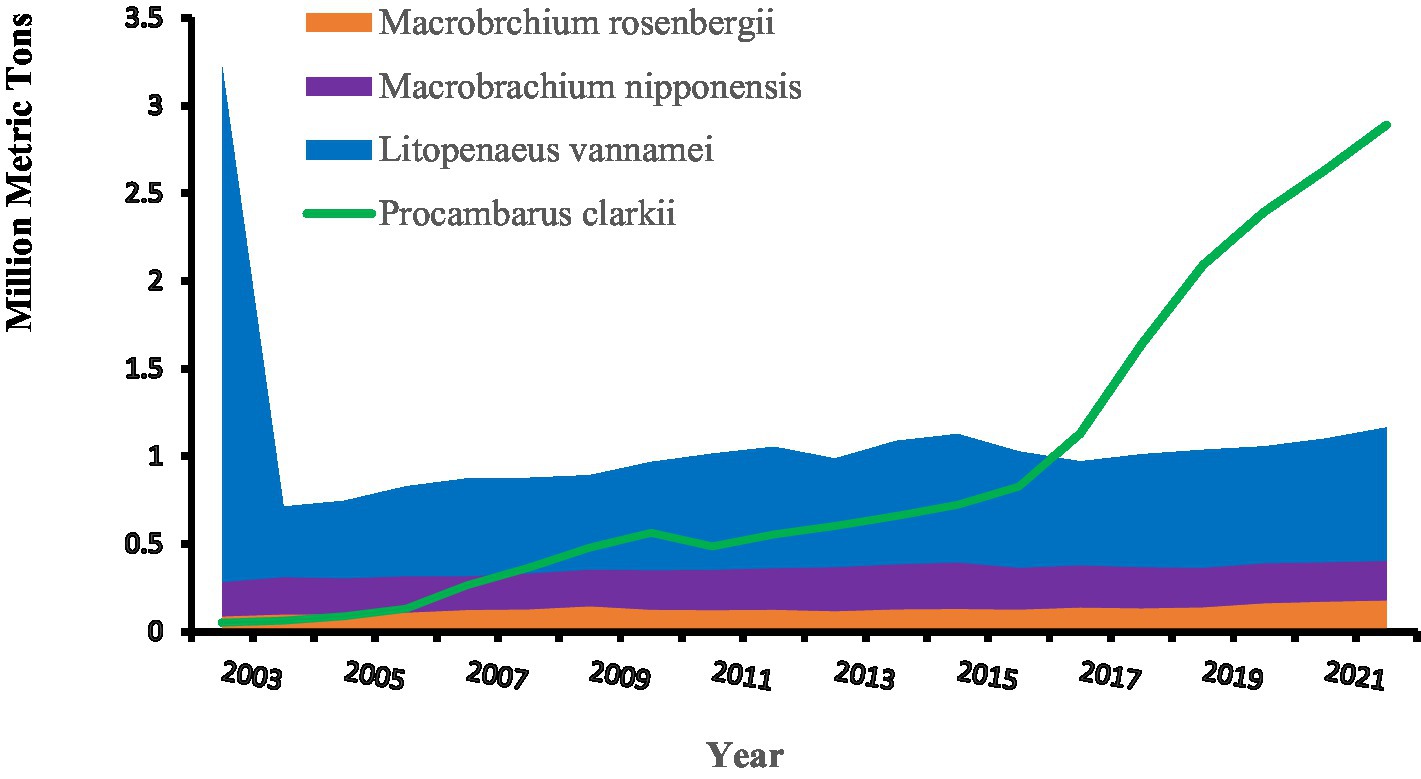
Figure 5. China’s freshwater shrimp aquaculture production by major species. Source: Authors, based on data from China Fishery Statistical Yearbooks, 2003–2022.
With their significant respective roles, wild-caught shrimp both in marine and freshwater showed a downward trend, while shrimp aquaculture production displayed an upward trend over the past 20 years (Figure 6). This demonstrates the steady efforts of the government to develop aquaculture and the whole fisheries sector in China. Aquaculture facilities in China have been upgraded, and the investment in capital, infrastructure, science and technology has been increased (Ren, 2021). For example, two major state-funded Basic Research programs in China (with 973 programs) that integrated many research teams from the Institute of Oceanology, Chinese Academy of Sciences, Third Institute of Oceanology, State Oceanic Administration, Zhejiang University, SUN YAT-SEN University and Shandong University were established in the 2000s to focus on shrimp immunology and disease control (Li and Xiang, 2013). In addition, advances in science and technology have played a vital role in intensifying production systems and species diversification in aquaculture. It is worth noting that the relaxation policies towards aquaculture development implemented in 1980s, with more focus on aquaculture as compared to fisheries in a global context of increasing overexploitation of fishery resources, has accelerated shrimp aquaculture in China. Thus, these efforts and investments have been productive and increased the share of shrimp aquaculture production in the country.
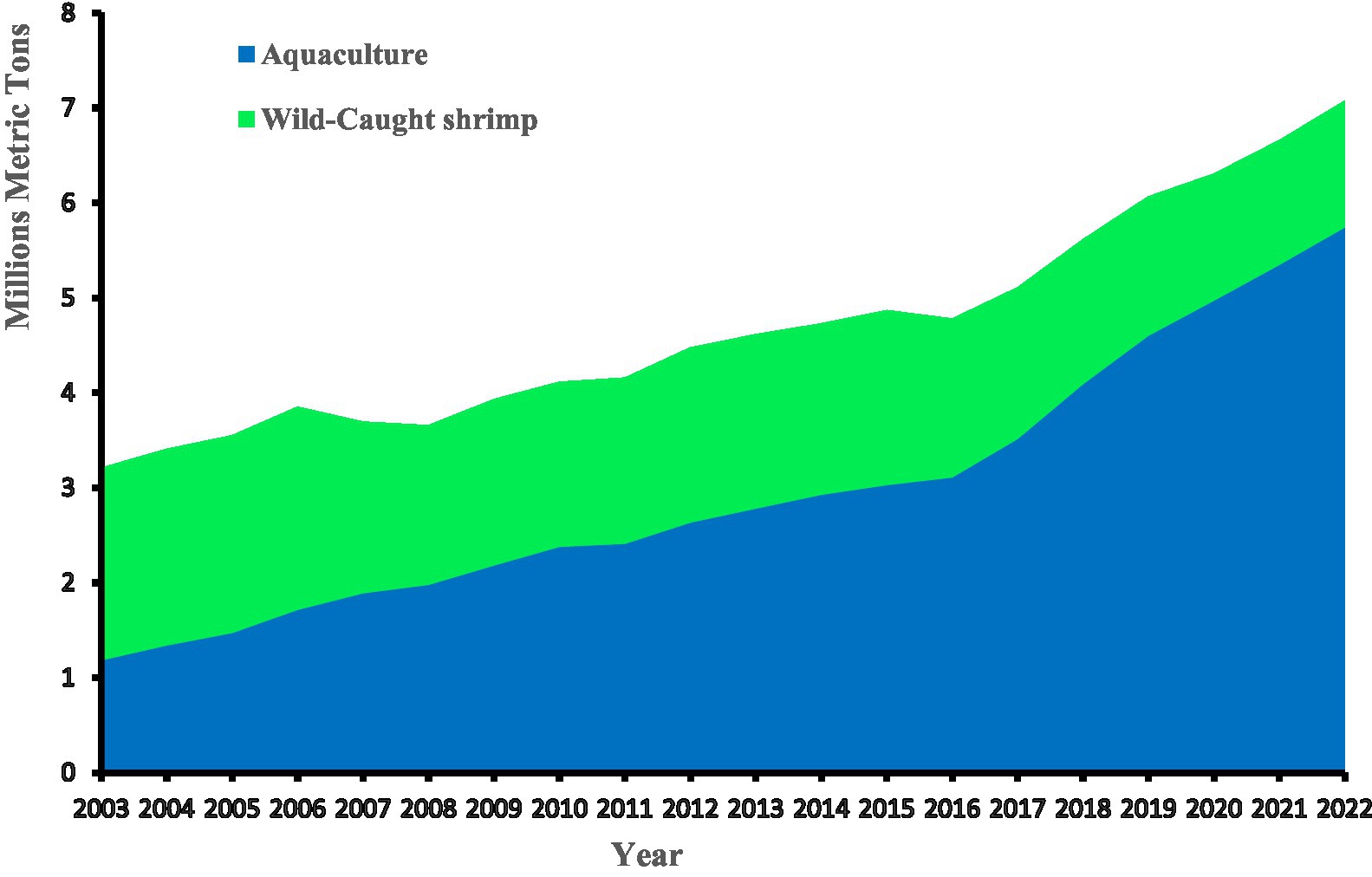
Figure 6. Trends in shrimp wild-caught and aquaculture production in China, 2003–2022. Source: Authors, based on data from China Fishery Statistical Yearbooks, 2003–2022.
3.4 China’s imports and exports of shrimp over the last decades
Since the late 1990s, consumer demand for shrimp and shrimp products has been strong in the Chinese market. At the same time, supply gaps are increasingly met through imports (FAO, 2023). In 2022, a large part of the increase in seafood imports to China were accounted for by shrimp. Indeed, imports of shrimp increased by 25.8% to 370,123 metric tons during the first half of 2022. They were mainly from Ecuador, India, Viet Nam, Canada, and Greenland, accounting for 60%, 12.5%, 6%, 3.6% and 3%, respectively. By the third quarter of the same year, cumulative imports rose in the market by 51.6% to 661,822 metric tons, which made China the world’s largest shrimp importer (Figures 7 A–E).
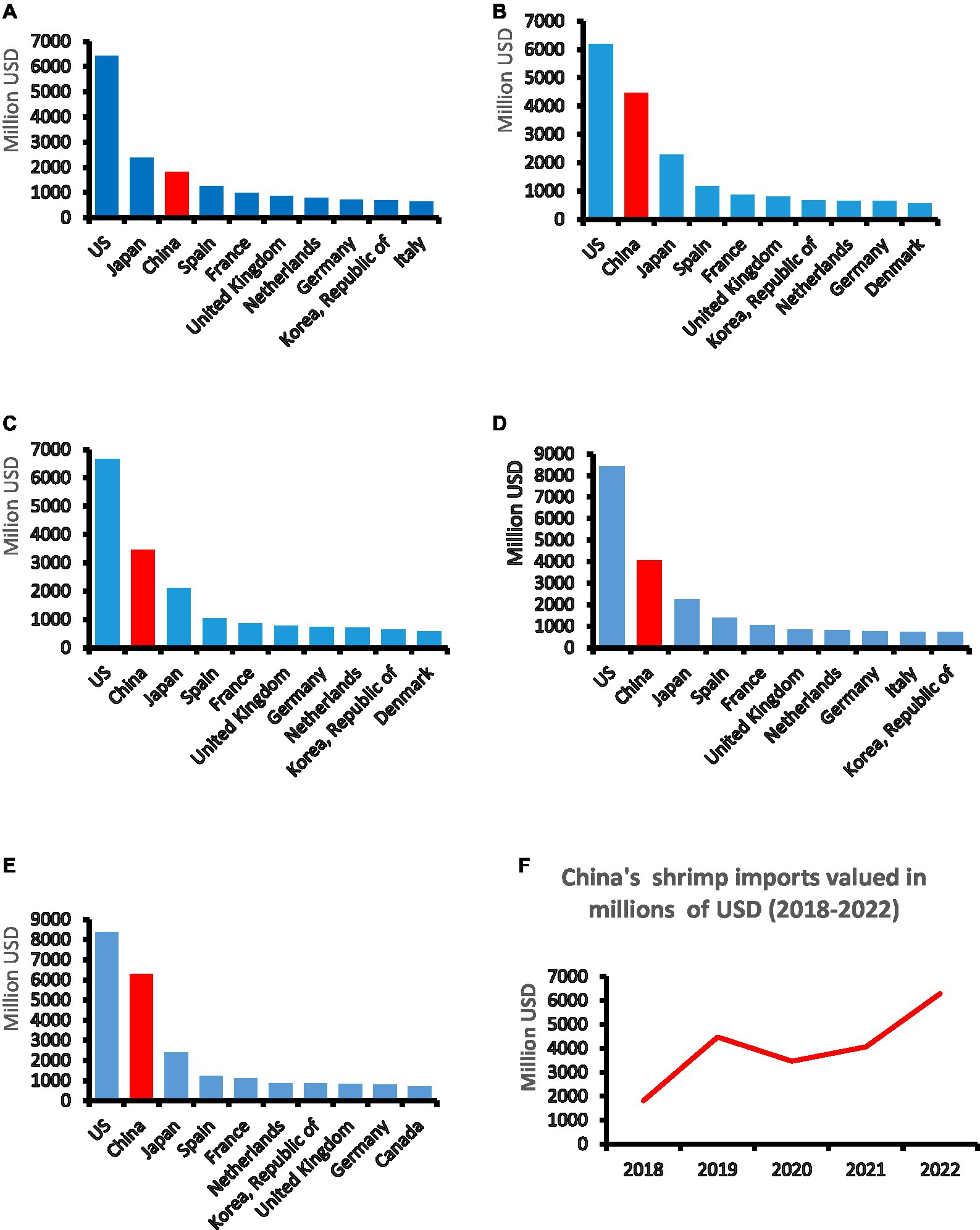
Figure 7. China’s shrimp imports among the world’s top ten shrimp importers, in 2018–2022 as shown in (A–E), respectively. (F) Trends in China’s shrimp imports valued in millions of USD (2018–2022). Source: Authors, based on FAO database, 2023.
Such a comparison with other top shrimp importers shows that China moved from the third rank in 2018 to be consecutively the second largest shrimp importer in the world for 4 years, from 2019 to 2022. In other words, except for 2018 where China ranked third for shrimp imports globally, China ranked the world’s second-largest shrimp importer behind the United States for four consecutive years, from 2019 to 2022 (see Figures 7A–E). Additionally, the overall trends in shrimp imports into China exhibited a sharp upward trend, wherein values increased from 1.81 billion USD in 2018 to 6.29 billion USD in 2022, which represents, on average, approximately 4 billion USD per year, during the last four years (Figure 7F). The observable slight decrease in shrimp imports into China between late 2019 and early 2020, might due to the deterioration of the international economic environment following the global health crisis and the lockdown restrictions related to it.
From an export perspective, since ever the theory of export-led growth had been the subject of significant academic research, shrimp is a fast-growing world export market. Indeed, the export-led growth hypothesis postulates that export expansion is one of the main determinants of growth. It is believed that a country’s economic growth can be achieved through an increase in labor and capital, coupled with an expansion of exports (Smith, 1776; Ricardo, 1817; Marshall, 1890; Balassa, 1978; Feder, 1983; Ram, 1987). This said, the Asian countries account for about 55% of total world shrimp exports (Khan et al., 2022). The top six shrimp exporters in Asia are India, Vietnam, Indonesia, Thailand, Bangladesh, and China, respectively, and all together account for more than 90% of the shrimp exports from Asia (OEC, 2021).
Figure 8 shows the top ten shrimp exporting countries in the world from 2018 to 2022. Similarly to the case with the imports, China is among the main exporters of shrimp in the world despite the high domestic demand and consumption that are likely to reduce the country’s capacity to export to other destinations. This is particularly possible thanks to the country’s considerable national production. It is worth noting that China only occupied a relative low rank among the top exporters, shifting from fourth in 2018 and 2019 to the world’s fifth largest shrimp exporter for the following 3 years. Indeed, in the past 4 years, shrimp exports from China have experienced an apparent decrease. As shown in Figure 8F, the country’s shrimp exports decreased from 2.4 billion USD in 2018 to 1.9 billion USD in 2022 and had reached the lowest of 1.6 billion USD in 2020. Similarly, the difference between exports and imports (hereinafter referred to as the net exports) from China, has an evident downward trend, with values declining from 0.6 billion to negative 4.3 billion USD in 2022 (Figure 9). This illustrates the importance of the domestic demand and consumption, which continue to drive both national production and imports. Apart from the fact that, globally, the United States (US) and China are the largest countries in terms of shrimp consumption globally (OEC, 2021), another reason for the huge shrimp imported into China might be that they are mostly processed and re-exported to other countries. Besides, despite China being a significant exporter of farmed and sea-caught shrimp, shrimp imports to the country are significantly higher in volume than exports. This outlines the large size of the country’s internal market (Asche et al., 2022).
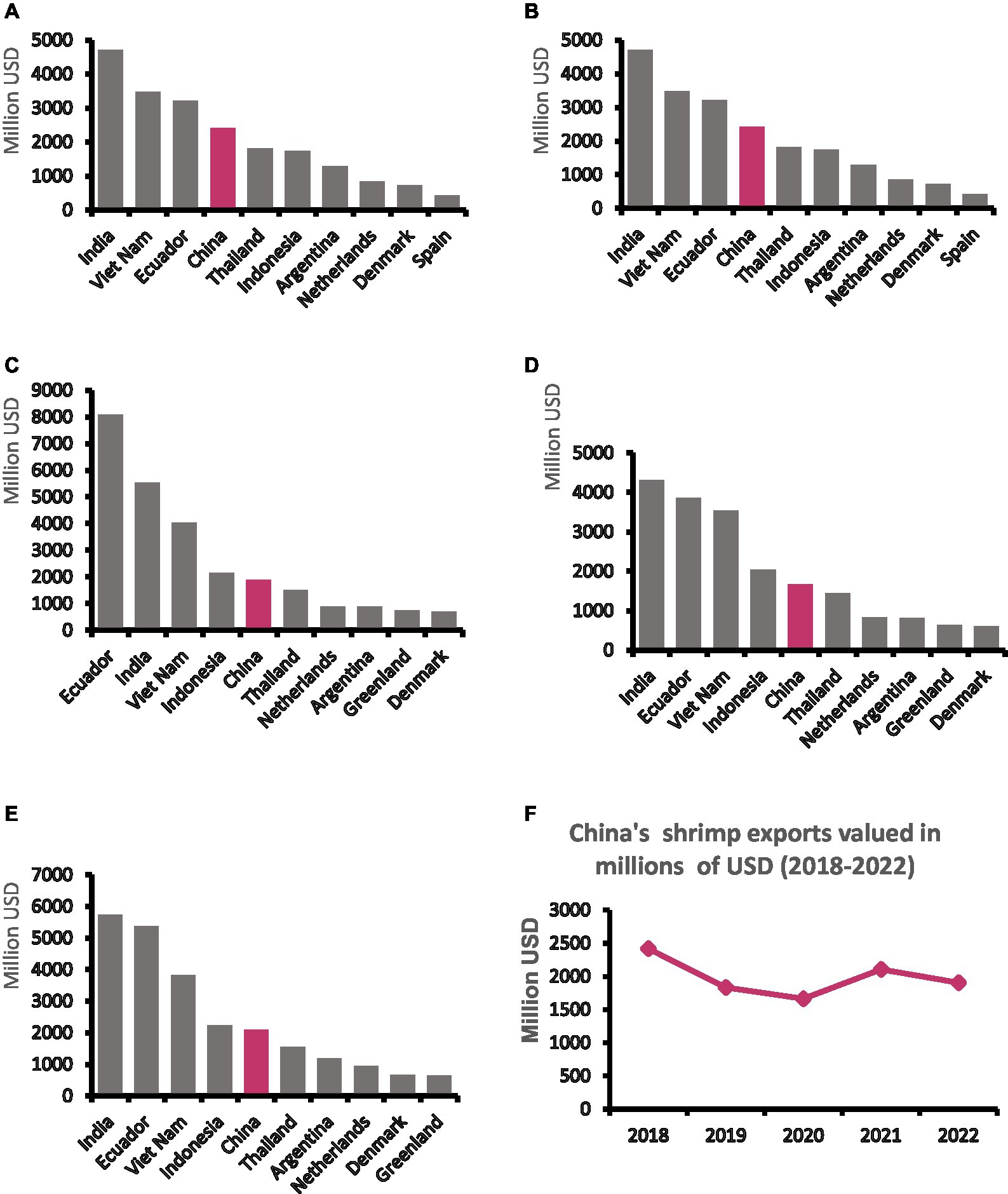
Figure 8. China’s shrimp exports among the world’s top ten shrimp exporting countries, in 2018–2022 as shown in (A–E), respectively. (F) Trends in China’s shrimp exports valued in millions of USD (2018–2022). Source: Authors, based on FAO database, 2023.
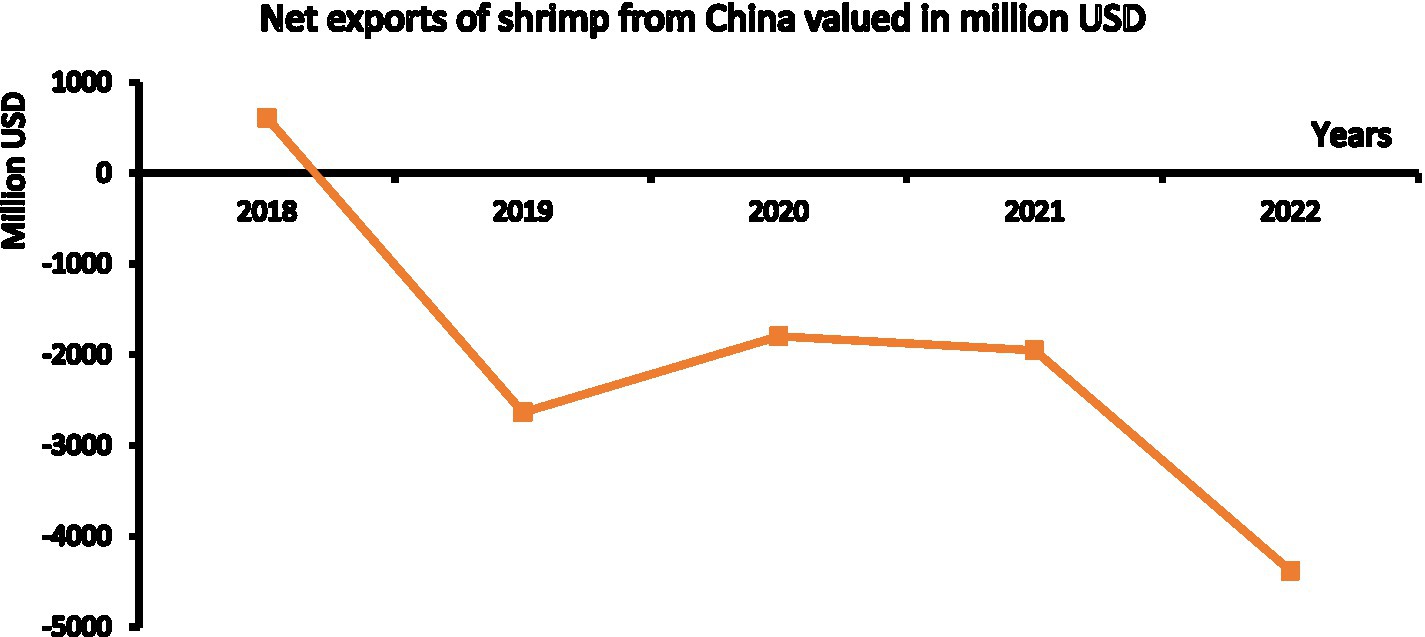
Figure 9. Trends in net exports of shrimp from China, valued in millions of USD (2018–2022). Source: Authors, based on FAO database, 2023.
3.5 Progress in shrimp aquaculture modes and technologies in China
Since the inception of wild juvenile shrimp farming following the establishment of the People’s Republic of China in 1949, considerable attention has been given to researching and promoting aquaculture modes and technologies. Efforts and projects in that regard aimed at improving yields, controlling costs, and increasing farmers’ benefits. Shrimp farming thus expanded from early extensive culture systems to intensive culture and, in between, the semi-intensive modes.
Shrimp aquaculture at large-scale in China can be traced back to the 1980s and, at the same time, implies the development of various farming systems and technology use since the mid-1990s. Thus, farming modes also witnessed constant enhancement and innovation, going from extensive culture to semi-intensive culture, and thereafter to land-based pond culture and greenhouse culture in the 1960s–1980s, 1980s–1990s, and in the early 2000s, respectively. For example, Artificial breeding and feeding techniques played a crucial role in the rapid expansion of shrimp farming in the early 1990s, allowing an annual production of over 200,000 MT. Similarly, these methods also helped scallops to become a more readily available product instead of being a high-value one (Wang, 2001).
Further, technological improvements namely in genetic, better pond management, vertical integration, and development of more environmentally sustainable production practices resulted globally in 9% annual growth from 1998 to 2001, with top shrimp producers, including China that contributed to such a growth (Kumar and Engle, 2016). Such technological advances of this time period set the stage for subsequent rapid expansion of shrimp aquaculture.
In addition, thanks to the government’s continuous improvements in infrastructure, technology, production facilities, China’s aquaculture capacity has been rising continuously. As a result, science and technology have played a significant role in improving the skills of workers in the aquaculture, especially in the shrimp sub-sector. Through technological research, demonstrations, training courses, and extension services, workers in the sector have been equipped with the scientific approach to shrimp farming (Wang, 2001). Hence, scientific and technological advancements were responsible for almost half of the increase in aquaculture production, leading to high returns on investment, particularly in shrimp farming, continues to have good prospects (N’Souvi et al., 2021).
Furthermore, the multi-trophic integrated system, which is an ecosystem-based farming mode, has emerged. Such an integrated culture evolves shrimp co-culture with fish, shellfish, crabs, seaweed or other species with the aim of gaining economic and socio-environmental benefits. These may include good harvests with larger fish products sizes, higher quality and market value, and being more environment-friendly. Thus, in China as elsewhere, a new pond-farming technique referred to as Biofloc technology has been considerably adopted by shrimp farmers in recent years (Cao et al., 2020; Abakari et al., 2022). It helps produce additional food sources (e.g., microbial biomass) to be used by the shrimps in addition to removing unutilized nutrients. Biofloc techniques also play a crucial role in the adjustments of dissolved-oxygen levels and in bio-control against diseases (El-Sayed, 2020; Khanjani and Sharifinia, 2022).
4 Discussion
Shrimp aquaculture has many socioeconomic and other benefits (N’Souvi et al., 2021; Xuan et al., 2021). Like the global shrimp industry, China’s shrimp industry has experienced rapid growth since the 1980s, thanks to technological breakthroughs and high demand for shrimp, leading to high prices and profits of its farming. Though many studies on shrimp farming in China have focused on different aspects, a very few of them have discussed the trends of its evolution in recent years and the challenges associated with such a rapid expansion. In the present study, it has been tried to present and discuss how the production of both wild-caught and aquaculture species, both freshwater and marine shrimp species has expanded in the last two decades, and the progress in shrimp aquaculture technology use, as well.
The results reveal that the aims of policies that have been implemented and concerns of shrimp farmers and other stakeholders in the sector have evolved over time. In the introductory phase of the Chinese shrimp industry, farmers, government and scientific teams had worked on the feasibility of domestication, especially of imported species. Then, thereafter this relatively long and perilous period, the general trend was profitability and marketing, which have required large-scale production. Despite its current profitability, which is overall satisfactory, the Chinese shrimp industry has seen the emergence of a number of challenges that have arisen from time to time. Indeed, the intensification of high-density shrimp farming has led to substantial environmental repercussions, including aquatic ecosystem degradation and material degradation. Its sustainability is supposed to give overall consideration to various aspects, including the population, market, quality, resources available, and environment, in order to ensure the supply of aquatic products to the generations to come based on the ecosystem carrying capacity (Wurts, 2000; Frankic and Hershner, 2003).
Besides, there has been a surge in bacterial and viral diseases (Febryano et al., 2017; Joffre et al., 2018). The environmental challenges with shrimp both wild-caught and aquaculture production in China as elsewhere in the world is likely to continue for the foreseeable future. In a word, the industry’ current situation is promising but with the ever increasing and alarming effects of climate change, microplastics, water pollution, continued efforts (investment, R&D, Science and technology, etc.,) are needed to ensure sustainable development of the industry.
The present review also indicates that adoption of Biofloc technology, among others, could be one of the alternatives and thus, help reduce the environmental impacts that derived from the conventional shrimp farming practices. The results presented in this paper provide some implications for a more sustainable development of shrimp aquaculture in China. Any policy for promoting the sector needs to take into account the perspective of environmental change. This information is very helpful to improve the current state of the country’s shrimp industry. That said, the challenges associated with the rapid expansion of shrimp aquaculture in developing countries, especially in rural poor areas should focus more on environmentally sustainable production.
4.1 Necessity to deal with disease occurrences
The first cases of disease were the serious outbreaks of shrimp diseases that have been reported in most of the largest shrimp-producing countries, including China (Villarreal, 2023). Acute problems of disease have emerged with the development, coupled with the intensification of farming practices and sales of shrimp on the international market, as well. In the early 2000s, various diseases were identified in cultured aquatic species, including shrimp and prawn culture in China (Wei et al., 2004).
Diseases have been one of the major constraints to shrimp farming sustainability in recent years (Yu et al., 2023). Severe shrimp outbreaks have taken place in many shrimp-producing areas. For example, the foremost among these are shrimp viral diseases that have affected production. Such diseases are most of the time linked to environmental issues related to the intensification of production. In order to make the maximum profit that helps cover the increasing production costs, especially the coastal land price, shrimp farmers tend to adopt more and more intensive practices. This includes an increased shrimp stock densities in the pond area, more feed, and other inputs per unit of pond area. This also results in increased effluents waste and a high risk of disease occurrence, which should be avoided at all costs.
4.2 The need for keep working on good quality of the fries and reasonable structure of shrimp aquaculture
In the past, the quality of shrimp fry was a serious issue that affected China’s shrimp (Weimin, 2005). The use of poor and medium qualities, mixed with inappropriate medicine has sometimes led to shrimp quality, which is not always high enough. Besides, some breeding techniques and the repeated use of broodstock by the hatchery stakeholders also result in a deterioration of the quality of shrimp fry, presenting another challenge for the industry today. Thus, all these issues could slow down the growth rate, and thus considerably add to the production cycle and increase the risks of disease occurrence as well. Farmers own efforts combined with government support could help the former to use more advanced technologies in order to lower their environmental footprint while increasing their economic productivity (Clapano et al., 2022). With government support, shrimp farmers can continue effectively dealing with issues including overuse of chemicals, poor or medium quality feed, since feed is a crucial component of any aquaculture production system as a means to improve the final output quality (Glencross et al., 2019). The increase in broodstock imports also could be part of an effort to improve more the quality and sustainability.
In addition, seasonal markets and the rapid expansion of shrimp production affect the economic returns of the farmers due to the fact that the price sometimes is too low in the domestic market. In some cases, shrimp farmers lack frequent extension services and appropriate market orientation. This may be rendering fragile certain shrimp farmers for the market competitiveness. In the international market, China’s shrimp export is facing strong pressure from non-tariff trade barrier policies implemented by other shrimp importing countries. This is another problem, a market issue that China’s shrimp industry might continue to address with a great deal of interest in the short to medium-term.
4.3 The need for minimizing water pollution and other environmental impacts
While fulfilling the global demand for seafood, aquaculture expansion raises among others, concerns about its impacts on biodiversity, environment and the emergence of pathogens (Abdel-Latif et al., 2022). To ensure its sustainability, the environmental impact must be assessed and science-based management measures be implemented (Hall et al., 2011).
Like the whole aquaculture industry, shrimp aquaculture industry generates considerable amounts of wastewater as effluents. Indeed, shrimp aquaculture damages the ecosystem of mangrove areas through converting mangrove wetlands to ponds for shrimp farming. Given water exchange in the ponds is needed during shrimp production, polluted effluents are often discharged into waterways, resulting not only into land and soil fertility diminution but also into hazarded human health (Rahman et al., 2013; Hossain and Hasan, 2017). Such untreated effluent released from shrimp aquaculture can cause serious environmental issues in the future and could affect the shrimp farming industry. Only a few farmers presently treat the effluents that derive from their shrimp ponds before releasing them to the natural environment. Very often, spoiled bait, shrimp excreta, wastes from medicines for shrimp and other biological waste products in water cause nitrogen, phosphorus and other organic wastes, which result in water pollution. For example, the economic loss caused by pollution from aquaculture in China was estimated to be more than three billion yuan in 2019 (Zhang et al., 2019). Only remedial treatments of effluents that derive from the whole food industry can alleviate the environmental hazards (Venugopal and Sasidharan, 2020).
Regarding other impacts on local environments and livelihoods, shrimp cultivation is increasing salinity by constructing canals. Such effects are not only observable in soil salinity of the lands in the farm where ponds are located but also that of the surrounding areas and lands (Alam et al., 2017). As such, soil fertility declines and vegetables or other crops production decreases. This said, the driven salinity intrusion in areas surrounding shrimp farms may reduce farmers and communities’ other livelihood production options (Islam and Tabeta, 2019). Furthermore, shrimp feed production affects climate change through an increase in the greenhouse gases in addition its effects on the ecosystem quality (Ramesh et al., 2023). The induced changes in the climate need to be minimized through appropriate ways and less emissions for a sustainable global shrimp aquaculture industry (Al Eissa et al., 2022).
4.4 The need for developing ecological and more healthier shrimp aquaculture
Ecological and healthy shrimp farming effectively improves the quality and safety of shrimp and shrimp products. It is also a crucial means to minimize factors that challenge the enhancement of the shrimp aquaculture industry (Sun et al., 2023). Developing ecological-friendly shrimp farming can be promoted in different ways.
First, promoting planting and breeding technologies for shrimp through the shrimp-vegetable technology enhancement. In addition, the Biofloc system is another farming technique that needs to be encouraged and promoted among shrimp farmers in China. This system, which consists of a modern practice for initial shrimp monoculture systems toward a more sustainability, has been used in shrimp culture by a few framers. It helps in reducing water usage by up to 90% as compared to traditional methods by maintaining water quality more effectively. Besides, Biofloc technique also enables culture at high stocking densities, manages land use waste, and optimizes the use of artificial food (Wasielesky et al., 2013; Krummenauer et al., 2014; Liu et al., 2017; Kumar et al., 2018). Furthermore, an integrated system of raising, for example, shrimp and tilapia, known as an integrated multi-trophic culture, could help minimize total suspended solids in the biofloc system. Adopting this kind of technology could allow farmers to use residues from one species to cultivate others.
5 Concluding remarks, and outlook
China’s shrimp industry has developed rapidly over the last two decades. Higher shrimp production is driven by expanded shrimp aquaculture production, with major species dominated by litopenaeus vannamei referred to as Penaeus monodon, Penaeus chinensis, and Penaeus japonicus. China has remained among the world top shrimp producers over the last two decades. However, some constraints and challenges threatening the industry have emerged. A growing number of diseases and other issues that have appeared in the shrimp industry in recent years may be associated with the speedy development of the industry. A better grasp of trends in the production, exports, and imports might help predict or avoid the occurrence of disease, and other challenges. Therefore, the development of innovative shrimp industry management approaches is of critical importance in any effort toward the industry’s sustainability.
First, the shrimp aquaculture industry should be farmed in a way that promotes the protection of the ecosystem and environment. Applying such an organic farming principle presupposes some practices or techniques for addressing the current issues threatening the sustainable growth of the industry. To that end, innovative techniques such as shrimp-vegetables technology, the Biofloc system and, integrated multitrophic culture of shrimp and other fish species should be more strengthened or encouraged. Second, appropriate techniques for diseases’ prevention, their early diagnosis, and their frequent control as well, should also be developed and improved. In addition, encouraging the use of good-quality feed in an appropriate quantity and form is also crucial. To that end, the government could continue helping shrimp farmers achieve the sustainable shrimp aquaculture through more ecological technology adoptions.
Furthermore, sustainably providing sufficient and healthier shrimp seafood for both domestic and international market is going to require more effort, given the global climate change influence in the evolution of the world, and which may continue over the coming decades with associated socioeconomic and environmental implications. While the present state of the shrimp aquaculture industry in China is somewhat sustainable, continuous effort and follow up need to be kept and improved. In summary, the following points should be addressed going forward:
• Future studies to explore an overall sustainability picture of the Chinese shrimp industry. For example, an “Economic analysis of the main drivers of shrimp aquaculture expansion in China over the years: Do international market price and shrimp consumption per capita in China matter?”.
• Further investigations are needed to better understand the socio-ecological dynamics of adopting shrimp-based systems in China as elsewhere in the world. For example, an “Analysis of externalities of shrimp aquaculture from economic and environmental viewpoints: Evidence from land use change in China”.
• Other outstanding questions need to be addressed, such as shrimp aquaculture farmers’ willingness to adopt ecological technologies, for example the Biofloc technology.
Author contributions
KN’: Conceptualization, Data curation, Investigation, Methodology, Software, Writing – original draft, Writing – review & editing. CS: Conceptualization, Funding acquisition, Investigation, Project administration, Supervision, Writing – review & editing. BC: Formal analysis, Resources, Writing – review & editing. AV: Formal analysis, Writing – review & editing.
Funding
The author(s) declare financial support was received for the research, authorship, and/or publication of this article. This work was supported by the Ministry of Agriculture and Rural Affairs of the People’s Republic of China through the China’s Agricultural Research System (Grant No CARS-48).
Acknowledgments
We wish to thank the reviewers for their valuable comments on previous versions of this manuscript.
Conflict of interest
The authors declare that the research was conducted in the absence of any commercial or financial relationships that could be construed as a potential conflict of interest.
Publisher’s note
All claims expressed in this article are solely those of the authors and do not necessarily represent those of their affiliated organizations, or those of the publisher, the editors and the reviewers. Any product that may be evaluated in this article, or claim that may be made by its manufacturer, is not guaranteed or endorsed by the publisher.
References
Abakari, G., Wu, X., He, X., Fan, L., and Luo, G. (2022). Bacteria in biofloc technology aquaculture systems: roles and mediating factors. Rev. Aquac. 14, 1260–1284. doi: 10.1111/raq.12649
Abdel-Latif, H. M. R., Yilmaz, E., Dawood, M. A. O., Ringø, E., Ahmadifar, E., and Yilmaz, S. (2022). Shrimp vibriosis and possible control measures using probiotics, postbiotics, prebiotics, and synbiotics: a review. Aquaculture 551:737951. doi: 10.1016/j.aquaculture.2022.737951
ADB/NACA. (1996). Aquaculture sustainability and the environment. Report on a regional study and workshop on aquaculture sustainability and the environment. Asian Development Bank and Network of Aquaculture Centres in Asia-Pacific, Bangkok, Thailand.
Al Eissa, A., Chen, P., Brown, P. B., and Huang, J. H. (2022). Effects of feed formula and farming system on the environmental performance of shrimp production chain from a life cycle perspective. J. Ind. Ecol. 26, 2006–2019. doi: 10.1111/jiec.13370
Alam, M. Z., Carpenter-Boggs, L., Mitra, S., Haque, M. M., Halsey, J., Rokonuzzaman, M., et al. (2017). Effect of salinity intrusion on food crops, livestock, and fish species at Kalapara Coastal Belt in Bangladesh. J. Food Qual. 2017, 1–23. doi: 10.1155/2017/2045157
Asche, F., Yang, B., Gephart, J. A., Smith, M. D., Anderson, J. L., Camp, E. V., et al. (2022). China's seafood imports-not for domestic consumption? Science 375, 386–388. doi: 10.1126/science.abl4756
Biao, X., and Kaijin, Y. (2007). Shrimp farming in China: operating characteristics, environmental impact and perspectives. Ocean Coast. Manag. 50, 538–550. doi: 10.1016/j.ocecoaman.2007.02.006
Cao, B. X., Abakari, G., Luo, G. Z., Tan, H., and Xia, W. (2020). Comparative analysis of nitrogen and phosphorus budgets in a bioflocs aquaculture system and recirculation aquaculture system during over-wintering of tilapia (GIFT, Oreochromis niloticus). Aquac. Eng. 89:102026. doi: 10.1016/j.aquaeng.2019.102026
Chao, L., Xiang, W., and Guo-feng, S. (2017). Spatio-temporal characteristics and changing trend of freshwater aquaculture production distribution in China. Jiangsu Agric. Sci. 45, 301–305. doi: 10.15889/j.issn.1002-1302.2017.15.076
Clapano, M. B., Diuyan, J. M. T., Rapiz, F. G. B., and Macusi, E. D. (2022). Typology of smallholder and commercial shrimp (Penaeus vannamei) farms, including threats and challenges in Davao region, Philippines. Sustainability 14:5713. doi: 10.3390/su14095713
Deng, Z., Zhang, Z., Zhao, R., Sun, J., Hao, P., Zhang, L., et al. (2023). Effects of high-salinity on the expression of aquaporins and ion transport-related genes in Chinese shrimp (Fenneropenaeus chinensis). Aquac. Rep. 30:101577. doi: 10.1016/j.aqrep.2023.101577
Dong, X., and Raghavan, V. (2022). Recent advances of selected novel processing techniques on shrimp allergenicity: a review. Trends Food Sci. Technol. 124, 334–344. doi: 10.1016/j.tifs.2022.04.024
Duan, Y., Tian, B., Li, X., Liu, D., Sengupta, D., Wang, Y., et al. (2021). Tracking changes in aquaculture ponds on the China coast using 30 years of Landsat images. Int. J. Appl. Earth Obs. Geoinf. 102:102383. doi: 10.1016/j.jag.2021.102383
El-Sayed, A. M. (2020). Use of biofloc technology in shrimp aquaculture: a comprehensive review, with emphasis on the last decade. Rev. Aquac. 13, 676–705. doi: 10.1111/raq.12494
Estrada-Perez, N., Ruiz-Velazco, J. M. J., and Hernández-Llamas, A. (2020). Economic risk scenarios for semi-intensive production of Litopenaeus (Penaeus) vannamei shrimp affected by acute hepatopancreatic necrosis disease. Aquac. Rep. 18:100442. doi: 10.1016/j.aqrep.2020.100442
FAO. (2000). Small ponds make a big difference. Available at: https://www.fao.org/3/x7156e/x7156e00.htm (Accessed August 17, 2023).
FAO. (2020). FishStatJ (Rome: FAO). Available at: www.fao.org/fishery/en/statistics/software/fishstatj/en (Accessed October 27, 2023).
FAO. (2021). Food and Agricultural Organization of the United Nations. Available at. http://www.fao.org (Accessed July 15, 2023).
FAO. (2022). The state of world fisheries and aquaculture 2022. Towards blue transformation. Rome, FAO.
FAO. (2023). Available at: https://www.fao.org/in-action/globefish/market-reports/resource-detail/en/c/1633618/ (Accessed July 19, 2023).
FAOSTAT (2023). Available at: http://www.fao.org/faostat/en/#data/FBS (Accessed November 5, 2023).
Febryano, I. G., Sinurat, J., and Salampessy, M. L. (2017). Social relation between businessman and community in management of intensive shrimp pond, 2nd International Conference on Tropical and Coastal Region Eco Development 2016, 55, 012042.
Feder, G. (1983). On exports and economic growth. J. Dev. Econ. 12, 59–73. doi: 10.1016/0304-3878(83)90031-7
Frankic, A., and Hershner, C. (2003). Sustainable aquaculture: developing the promise of aquaculture. Aquac. Int. 11, 517–530. doi: 10.1023/B:AQUI.0000013264.38692.91
Fu, T., Zhang, L., Yuan, X., Chen, B., and Yan, M. (2021). Spatio-temporal patterns and sustainable development of coastal aquaculture in Hainan Island, China: 30 years of evidence from remote sensing. Ocean Coast. Manag. 214:105897. doi: 10.1016/j.ocecoaman.2021.105897
Glencross, B. D., Baily, J., Berntssen, M. H. G., Hardy, R., MacKenzie, S., and Tocher, D. R. (2019). Risk assessment of the use of alternative animal and plant raw material resources in aquaculture feeds. Rev. Aquac. 12, 703–758. doi: 10.1111/raq.12347
Hall, S. J., Delaporte, A., Phillips, M. J., Beveridge, M., and O'Keefe, M. (2011). Blue frontiers: managing the environmental costs of aquaculture. The WorldFish Center, Penang, Malaysia, 92 p. Available at: https://digitalarchive.worldfishcenter.org/bitstream/handle/20.500.12348/1148/WF_2821.pdf?sequence1= (Accessed July 29, 2023).
Han, C., Li, L., Zhang, G., Dong, S., and Tian, X. (2021). Assessment of elemental profiling combined with chemometrics for authenticating the geographical origins of Pacific white shrimp (litopenaeus vannamei). Food Control 130:108231. doi: 10.1016/j.foodcont.2021.108231
Hossain, M. A. R., and Hasan, M. R. (2017). An assessment of impacts from shrimp aquaculture in Bangladesh and prospects for improvements. FAO fisheries and aquaculture technical paper no. 618. Food and Agriculture Organization of the United Nations. Available at: https://issuu.com/aquacultureasiapacific/docs/aq22176_aap_julaug_22_fa_lr/s/16417856 (Accessed October 10, 2023).
Hu, F., Zhong, H., Wu, C., Wang, S., Guo, Z., Tao, M., et al. (2021). Development of fisheries in China. Reprod. Breed. 1, 64–79. doi: 10.1016/j.repbre.2021.03.003
Huang, Z., Guan, W., Lyu, X., Chen, R., Wu, Y., and Mao, L. (2024). Impacts of acute ammonia-N exposure on the muscle quality of whiteleg shrimp (Penaeus vannamei): novel insights into lipid and protein oxidation. Food Chem. 437:137781. doi: 10.1016/j.foodchem.2023.137781
IMF. (2023). Global price of Shrimp [PSHRIUSDQ], FRED, Federal Reserve Bank of St. Louis. Available at: https://fred.stlouisfed.org/series/PSHRIUSDQ (Accessed November 8, 2023).
Islam, M. R., and Tabeta, S. (2019). Shrimp vs prawn-rice farming in Bangladesh: a comparative impacts study on local environments and livelihoods. Ocean Coast. Manag. 168, 167–176. doi: 10.1016/j.ocecoaman.2018.11.004
Jin, S., Jacquin, L., Xiong, M., Li, R., Lek, S., Li, W., et al. (2019). Reproductive pattern and population dynamics of commercial red swamp crayfish (Procambarus clarkii) from China: implications for sustainable aquaculture management. PeerJ 7:e6214. doi: 10.7717/peerj.6214
Joffre, O. M., Klerkx, L., and Khoa, T. N. D. (2018). Aquaculture innovation system analysis of transition to sustainable intensification in shrimp farming. Agron. Sustain. Dev. 38, 1–11. doi: 10.1007/s13593-018-0511-9
Joshi, J., Srisala, J., Truong, V. H., Chen, I. T., Nuangsaeng, B., Suthienkul, O., et al. (2014). Variation in Vibrio parahaemolyticus isolates from a single Thai shrimp farm experiencing an outbreak of acute hepatopancreatic necrosis disease (AHPND). Aquaculture 428-429, 297–302. doi: 10.1016/j.aquaculture.2014.03.030
Kautsky, N., Ronnback, P., Tedengren, M., and Troell, M. (2000). Ecosystem perspectives on management of disease in shrimp pond farming. Aquaculture 191, 145–161. doi: 10.1016/S0044-8486(00)00424-5
Khan, M. A., Hossain, M. E., Islam, M. S., Rahman, M. T., and Dey, M. M. (2022). Shrimp export competitiveness and its determinants: a novel dynamic ARDL simulations approach. Aquac. Econ. Manag. 27, 221–248. doi: 10.1080/13657305.2022.2089772
Khanjani, M. H., and Sharifinia, M. (2022). Biofloc technology with addition molasses as carbon sources applied to litopenaeus vannamei juvenile production under the effects of different C/N ratios. Aquac. Int. 30, 383–397. doi: 10.1007/s10499-021-00803-5
Krummenauer, D., Samocha, T., Poersch, L., Lara, G., and Wasielesky, W. (2014). The reuse of water on the culture of pacific white shrimp, litopenaeus vannamei, in BFT system. J. World Aquacult. Soc. 45, 3–14. doi: 10.1111/jwas.12093
Kumar, G., and Engle, C. R. (2016). Technological advances that led to growth of shrimp, Salmon, and Tilapia farming. Rev. Fish. Sci. Aquac. 24, 136–152. doi: 10.1080/23308249.2015.1112357
Kumar, V. S., Pandey, P. K., Anand, T., Bhuvaneswari, G. R., Dhinakaran, A., and Kumar, S. (2018). Biofloc improves water, effluent quality and growth parameters of penaeus vannamei in an intensive culture system. J. Environ. Manage. 215, 206–215. doi: 10.1016/j.jenvman.2018.03.015
Li, X., Li, J., Wang, Y., Fu, L., Fu, Y., Li, B., et al. (2011). Aquaculture industry in China: current state, challenges, and outlook. Rev. Fish. Sci. 19, 187–200. doi: 10.1080/10641262.2011.573597
Li, F., and Xiang, J. (2013). Recent advances in researches on the innate immunity of shrimp in China. Dev. Comp. Immunol. 39, 11–26. doi: 10.1016/j.dci.2012.03.016
Li, T., Zhang, B., Zhu, C., Su, J., Li, J., Chen, S., et al. (2021). Effects of an ex situ shrimp-rice aquaponic system on the water quality of aquaculture ponds in the Pearl River estuary, China. Aquaculture 545:737179. doi: 10.1016/j.aquaculture.2021.737179
Liu, W., Luo, G., Li, L., Wang, X., Wang, J., Ma, N., et al. (2017). Nitrogen dynamics and biofloc composition using biofloc technology to treat aquaculture solid waste mixed with distillery spent wash. N. Am. J. Aquac. 79, 27–35. doi: 10.1080/15222055.2016.1223769
Liu, H., Shen, M., He, Y., Li, B., Pu, L., Xia, G., et al. (2023). Analysis of differentially expressed proteins after EHP-infection and characterization of caspase 3 protein in the whiteleg shrimp (litopenaeus vannamei). Fish Shellfish Immunol. 135:108698. doi: 10.1016/j.fsi.2023.108698
MacLeod, M. J., Hasan, M. R., Robb, D. H. F., and Mamun-Ur-Rashid, M. (2020). Quantifying greenhouse gas emissions from global aquaculture. Sci. Rep. 10:11679. doi: 10.1038/s41598-020-68231-8
Mansour, A. T., Ashour, M., Alprol, A. E., and Alsaqufi, A. S. (2022). Aquatic plants and aquatic animals in the context of sustainability: cultivation techniques, integration, and blue revolution. Sustainability 14:3257. doi: 10.3390/su14063257
Meng, X., Wang, Q., Jie Kon, J., Li, J., and Huang, J. (2015). Shrimp farming in China: lessons from its developmental history. Available at: https://VICTORNKODJ/downloads/shrimp-farming-in-China-what-should-we-learn-from-its-developmental-history.Pdf (Accessed July 24, 2023).
N’Souvi, K., Sun, C., and Che, B. (2021). Aquaculture technology adoption and profitability of the polyculture system practiced by prawn and crab farmers: case study of Anhui Province in China. Aquac. Rep. 21:100896. doi: 10.1016/j.aqrep.2021.100896
Newton, R., Zhang, W., Xian, Z., McAdam, B., and Little, D. C. (2021). Intensification, regulation and diversification: the changing face of inland aquaculture in China. Ambio 50, 1739–1756. doi: 10.1007/s13280-021-01503-3
OEC. (2021). Shrimps and prawns, frozen. Available at: https://oec.world/en/profile/hs92/shrimps-and-prawns-frozen (Accessed August 5, 2023).
Rahman, M. M., Giedraitis, V. R., Lieberman, L. S., Akhtar, M. T., and Taminskiene, V. (2013). Shrimp cultivation with water salinity in Bangladesh: thee implications of an ecological model. Univers. J. Public Health 1, 131–142. doi: 10.13189/UJPH.2013.010313
Ram, R. (1987). Exports and economic growth in developing countries: evidence from time-series and cross-section data. Econ. Dev. Cult. Chang. 36, 51–72. doi: 10.1086/451636
Ramesh, P., Jasmin, A. S., Tanveer, M., Ganeshan, P., Rajendran, K., Kamilya, D., et al. (2023). Environmental impacts and effects on greenhouse gas emissions in shrimp feed production system for aquaculture – a case study in India. Environ. Res. 241:117348. doi: 10.1016/j.envres.2023.117348
Ren, W. (2021). What forces drive the rapid development of mariculture in China: factor-driven or total factor productivity-driven? Aquac. Res. 52, 3966–3977. doi: 10.1111/are.15240
Ricardo, D. (1817). “On the principles of political economy and taxation” in The works and correspondence of David Ricardo, Vol. 1. ed. P. Sraffa (Cambridge: Cambridge University Press)
Shinn, A. P., Pratoomyot, J., Griffiths, D., Trong, T. Q., Vu, N. T., Jiravanichpaisal, P., et al. (2018). Asian shrimp production and the economic costs of disease. Asian Fish. Sci. 31S, 29–58. doi: 10.33997/j.afs.2018.31.s1.003
Smith, A. (1776). An inquiry into the nature and causes of the wealth of nations. History of Economic Thought Books, McMaster University Archive for the History of Economic Thought, Number Smith 1776.
Sun, Y., Hou, H., Dong, D., Zhang, J., Yang, X., Li, X., et al. (2023). Comparative life cycle assessment of whiteleg shrimp (Penaeus vannamei) cultured in recirculating aquaculture systems (RAS), biofloc technology (BFT) and higher-place ponds (HPP) farming systems in China. Aquaculture 574:739625. doi: 10.1016/j.aquaculture.2023.739625
Thitamadee, S., Prachumwat, A., Srisala, J., Jaroenlak, P., Salachan, P. V., Sritunyalucksana, K., et al. (2016). Review of current disease threats for cultivated penaeid shrimp in Asia. Aquaculture 452, 69–87. doi: 10.1016/j.aquaculture.2015.10.028
Venugopal, V., and Sasidharan, A. (2020). Seafood industry effluents: environmental hazards, treatment and resource recovery. J. Environ. Chem. Eng. 9:104758. doi: 10.1016/j.jece.2020.104758
Villarreal, H. (2023). Shrimp farming advances, challenges, and opportunities. World Aquac. Soc. 54, 1092–1095. doi: 10.1111/jwas.13027
Wang, Y. (2001). “China P.R.: a review of national aquaculture development” in Aquaculture in the Third Millennium. Technical Proceedings of the Conference on Aquaculture in the Third Millennium, Bangkok, Thailand, 20–25 February 2000. eds. R. P. Subasinghe, P. Bueno, M. J. Phillips, C. Hough, S. E. McGladdery, and J. R. Arthur (Rome: NACA, Bangkok and FAO), 307–316.
Wang, J., Che, B., and Sun, C. (2022). Spatiotemporal variations in shrimp aquaculture in China and their influencing factors. Sustainability 14:13981. doi: 10.3390/su142113981
Wang, O., Somogyi, S., and Ablett, R. (2021). The influences of quality attributes and socio-demographics on Chinese consumers' general and online consumptions of Canadian, US and Australian lobsters. Br. Food J. 123, 2289–2306. doi: 10.1108/BFJ-12-2020-1101
Wasielesky, W., Froes, C., Fóes, G., Krummenauer, D., Lara, G., and Poersch, L. (2013). Nursery of litopenaeus vannamei reared in a biofloc system: the effect of stocking densities and compensatory growth. J. Shellfish Res. 32, 799–806. doi: 10.2983/035.032.0323
Wei, Q., He, J., Yang, D., Zheng, W., and Li, L. (2004). Status of sturgeon aquaculture and sturgeon trade in China: a review based on two recent nationwide surveys. J. Appl. Ichthyol. 20, 321–332. doi: 10.1111/j.1439-0426.2004.00593.x
Weimin, M. (2005). Status of aquaculture of Penaeus vannamei in China. In: Regional technical consultation on the aquaculture of P. Vannamei and other exotic shrimps in Southeast Asia, Manila, Philippines (pp. 84–91). Tigbauan, Iloilo, Philippines: SEAFDEC Aquaculture Department. Available at: https://core.ac.uk/download/pdf/10863547.pdf (Accessed November 4, 2023).
Wurts, W. A. (2000). Sustainable aquaculture in the twenty-first century. Rev. Fish. Sci. 8, 141–150. doi: 10.1080/10641260091129206
Xuan, B. B., Sandorf, E. D., and Ngoc, Q. T. K. (2021). Stakeholder perceptions towards sustainable shrimp aquaculture in Vietnam. J. Environ. Manag. 290:112585. doi: 10.1016/j.jenvman.2021.112585
Yu, Y., Tang, M., Wang, Y., Liao, M., Wang, C., Rong, X., et al. (2023). Virulence and antimicrobial resistance characteristics assessment of Vibrio isolated from shrimp (Penaeus vannamei) breeding system in South China. Ecotoxicol. Environ. Saf. 252:114615. doi: 10.1016/j.ecoenv.2023.114615
Zhang, X.-G. (2007). “Aquaculture in China” in Species and system selection for sustainable aquaculture. eds. P. S. Leung, C.-S. Lee, and P. J. O'Bryen (Hoboken, NJ: Blackwell Publishing), 131–144.
Zhang, X. L., Cui, L., Li, S., Liu, X., Han, X., and Jiang, K. (2019). China fishery statistical yearbook.
Keywords: shrimp aquaculture industry, challenges, outlook, ecological farming, sustainability, China
Citation: N’Souvi K, Sun C, Che B and Vodounon A (2024) Shrimp industry in China: overview of the trends in the production, imports and exports during the last two decades, challenges, and outlook. Front. Sustain. Food Syst. 7:1287034. doi: 10.3389/fsufs.2023.1287034
Edited by:
Jemimah Etornam Kassah, University of Education, Winneba, GhanaReviewed by:
Heman Das Lohano, Institute of Business Administration, Karachi, PakistanDavid Alejandro González-Rivas, Metropolitan Autonomous University, Mexico
Ha Truong, Commonwealth Scientific and Industrial Research Organisation (CSIRO), Australia
Copyright © 2024 N’Souvi, Sun, Che and Vodounon. This is an open-access article distributed under the terms of the Creative Commons Attribution License (CC BY). The use, distribution or reproduction in other forums is permitted, provided the original author(s) and the copyright owner(s) are credited and that the original publication in this journal is cited, in accordance with accepted academic practice. No use, distribution or reproduction is permitted which does not comply with these terms.
*Correspondence: Chen Sun, Y2hlbnN1bkBzaG91LmVkdS5jbg==
 Kodjo N’Souvi
Kodjo N’Souvi Chen Sun1*
Chen Sun1* Bin Che
Bin Che